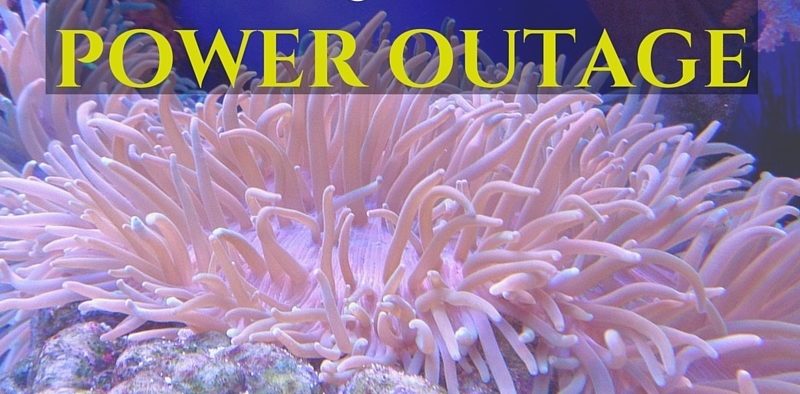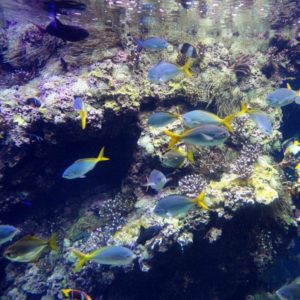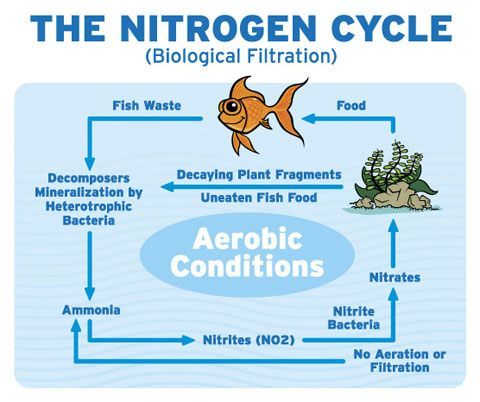Keeping Aquariums Alive During Power Outage
Share

Summer is here, and that means possible brown outs (power shortages) and even blackouts (power outages) for most of the country. Things get more complex when we have fish and aquariums; which is why it’s so important to have a backup plan in case power goes out for longer than a few hours. Here is how you can plan ahead to keep fish alive during a power outage.
What Happens During Power Outages
When power to your aquarium stops, there are three critical events that occur:
- Aquarium water temperature fluctuates
- Oxygen depletes from water
- Ammonia accumulates in water
Today we’re taking a look at each of these things in detail and offering a few suggestions on how you can prepare for a brownout or blackout in your area of the country.
Aquarium Water Temperature Begins Fluctuating
Your aquarium temperature is one of the most important factors in the health of your tank. Rapid changes in water temperature not only stress out your fish, it puts them at risk for disease. If you’re not monitoring your aquarium temperatures, you need to start.
Temperature changes can shock your fish as temperature changes begin to be less stable. Too hot and your fish will die, too cold and your fish will die. The optimum temperature for tropical fish is between 75°– 80° F or (24° – 26.5°C). Of course, this will depend on the type of fish and aquarium that you have.
As temperature increases, water also loses its ability to retain oxygen. Since salt water contains less oxygen than fresh water, oxygen depletion occurs much faster in marine aquariums. While tropical fish can generally handle warmer temperatures, living reefs, coral and reef invertebrates typically prefer cooler temps.
One thing you can do to stay prepared is keep clean, purified, frozen water in gallon jugs in your freezer.

How to Change the Aquarium Temperature
When the power grid fails, the first thing you should do is attempt to keep the temperature of aquarium water stable.
In absolutely emergencies where the power has been out and the temperature is above 83 F, you can attempt to cool your tank down. If you’re in hot environment (like Arizona in summer), keep a few gallon jugs of water frozen at all times. You can place them one in your aquarium to keep the water cooler. Not only can these jugs cool your aquarium, they can be moved to your refrigerator to help keep food cool.
Read about ways to control temperature during winter in Keeping You and Your Pets Safe Without Power in Winter
Oxygen Depletion and Water Movement
In order to maintain a healthy aquarium, you must have water movement. This movement is what helps aerate and replenish oxygen in the water. When your aquarium water stops moving, it loses its ability to retain oxygen and filter out toxins. A power outage can disrupt the vital water flow in your aquarium.

Photo:Algone
Here are three ways to get some movement going during this time:
Stagnant water can cause your fish to suffocate in a matter of days. But, there are a few things you can do to delay the depletion of oxygen.
- Battery-powered air pump: Invest in a battery-powered air pump specifically designed for aquariums. This will inject air bubbles into the water, increasing oxygen levels and generating gentle water circulation.
- Manual water agitation: If you don’t have a battery pump, you can manually create water flow. Carefully scoop up tank water and pour it back in from a height. This disrupts the surface and encourages some circulation. Remember, this may stress your fish out.
- Air stone alternative: In a pinch, if you lack both a pump and extra tank water, you can create a temporary air source. One way to help promote better gas exchange is to place air stones at the water’s surface (rather than at the bottom of the tank, which is where you are likely accustomed to keeping them). Vigorously stir the water with an airline tubing (the plastic hose used for air pumps) to introduce air bubbles for a short-term oxygen boost. Remember, this is not as effective as the other methods.
Ammonia Begins to Build
Filtration is super important for aquariums because it helps remove ammonia from the tank. Since fish can create high levels of ammonia, this water movement is critical for your tank’s health. It only takes a few hours for ammonia to elevate and become toxic. A power outage can threaten your fish by hindering the beneficial bacteria in your filter that convert harmful ammonia from fish waste. Here’s how to slow down ammonia buildup during this critical time:
- Minimize feeding: Since fish aren’t actively swimming and expending energy, reduce feeding or stop altogether. This lowers the amount of waste produced, giving the beneficial bacteria a fighting chance to keep up with ammonia conversion, even at a reduced rate.
- Test Your Water Frequently: Perform water tests on your aquarium throughout the day, paying close attention to the pH and ammonia nitrate levels. If you see any increases, it’s time to use an ammonia detoxifier.
- Use an Ammonia Detoxifier: your power is out for a long period of time and you notice an increase in ammonia developing, use a fast-acting ammonia detoxifier to neutralize the acid. We like the one from API called Ammo-Lock, but there are many detoxifiers on the market.
This is particularly important during long-term power outages that last longer than two-three days. You’ll also want to use the ammonia detoxifier just after turning your filters back on. This can help prevent an ammonia spike from the stagnant filtration.
Be Prepared
There are a number of things you can do to prepare your tank for a power loss.
- Invest in Ground Fault Circuit Interrupters (GFCIs). These prevent damage to electrical circuits and can save you lots of money in not having to replace costly aquarium equipment in the case of a brownout or black out.
- Disconnect Electrical Components: If you’re at home when the power goes out, disconnect your electrical components. Then when the power comes back on, your tank won’t be hit with a surge that may trigger other problems.
- Reduce Stock: If you have an overcrowded aquarium, it’s time to either upgrade the tank or downsize the fish. Overcrowded tanks produce much more waste. This can escalate problems if the power goes out.
Being aware of what to do during a power outage will help you as most times, you will not have access to the internet to search out answers. If this article helped you, please share with a friend!










